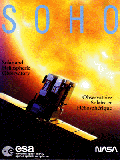 |
Lesson:
Differential Rotation of the Sun(Grades 9-12)
|
Teacher Information
The Sun has a north and south pole, just as the Earth does, and rotates
on its axis. However, unlike Earth which rotates at all latitudes every
24 hours, the Sun rotates every 25 days at the equator and takes
progressively longer to rotate at higher latitudes, up to 35 days
at the poles. This is known as
differential rotation.
The Sun rotates in the same direction as Earth.
The Carrington Rotations are named for Richard Carrington, an astronomer who
first noted that sunspots rotate every 27.28 days. Rotations are numbered
starting with 9 November 1853. The 1996 Jun 18 - 1996 July 15 rotation is
rotation number 1924.
This lesson uses SOHO data from the
EIT(Extreme-ultraviolet Imaging Telescope) instrument on the spacecraft.
Activity: Longitude and Latitude
(Students become familiar with locating positions on a sphere,
appropriate for grades 9-12)
Materials:
- Globe indicating longitude and latitude lines.
- Printouts of EIT images and a NOAO spherical grid.
- Individual student science notebooks or paper.
Type of Activity:
- Lecture/Discussion
- Location of places on Earth
- Plotting active regions on the sun.
Procedure:
- Review longitude and latitude
- Students locate places on a globe, given longitude and latitude
- Make connection from Earth to Sun.
- The Sun is described by longitude and latitude lines.
- Introduce Carrington Rotation
- A numbering of rotations starting from 1853.
- Given a seven day sequence of EIT images, students plot two active
areas on a solar grid.
- A good set of data is that of
Aug. 24 - 30, 1996, where two clear sets of solar activity are visible,
one at -10 latitude and one at -30 latitude.
- Once the seven images are retrieved
print out the solar grid. Note that the grid has
36 divisions. (Remember the sun is spherical: 18 in front and 18 in back.
Some are closer together than others, due to perspective, but all are equal.)
- By holding the grid over the image up to the light, or on an overhead
projector, students
can mark sequential locations of these active regions.
- For the -10
latitude active region, days 27-30, the spot has traveled 4/36 (1/9) of the
distance around the sun in 3 days. Therefore its projected time of rotation
at -10 latitude is 9x3 = 27 days.
- For the -30 latitude region, from day
24 to day 29, the spot passes through 6/36 (1/6) of the solar sphere in 6
days Therefore its projected time of rotation at -30 latitude is 6x6 = 30
days.
- Independent Student Research: Students study images
of the sun for a period of 2 - 3 months, track active regions at different
latitudes, and calculate differential rotations.

